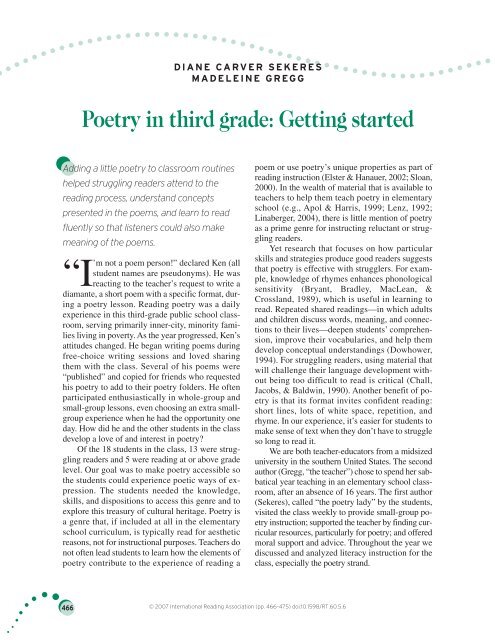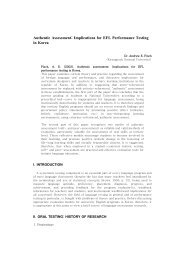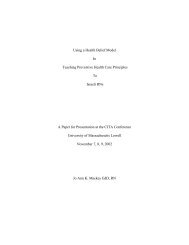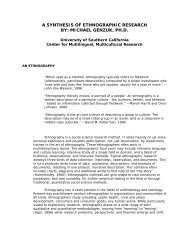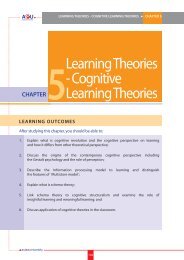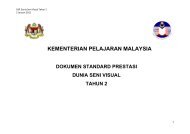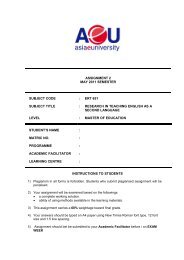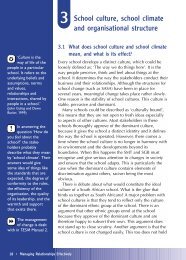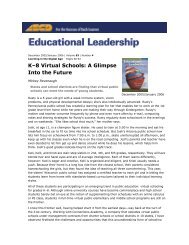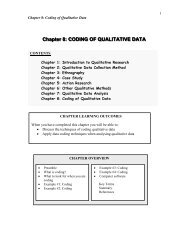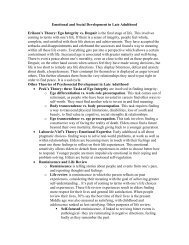Poetry in third grade: Getting started
Poetry in third grade: Getting started
Poetry in third grade: Getting started
- No tags were found...
You also want an ePaper? Increase the reach of your titles
YUMPU automatically turns print PDFs into web optimized ePapers that Google loves.
This article reports our classroom structuresand rout<strong>in</strong>es for teach<strong>in</strong>g poetry, examples of poetrylessons, and criteria for select<strong>in</strong>g poems forthese particular <strong>third</strong>-<strong>grade</strong> students. For manyteachers, the potential of poetry rema<strong>in</strong>s elusive.We offer these ideas <strong>in</strong> the hope that other teacherswill develop the courage and confidence to usepoetry <strong>in</strong> their own literacy <strong>in</strong>struction.Classroom structures and rout<strong>in</strong>esWe used whole-group and small-group structuresto support poetry <strong>in</strong>struction and performance.With<strong>in</strong> these structures, classroom rout<strong>in</strong>esdeveloped to give the students a measure of anticipation,as well as the security of familiarity, andcontributed to their sense that participation <strong>in</strong> theirown education was expected and desired.Rout<strong>in</strong>es for whole-group <strong>in</strong>structionA 90-m<strong>in</strong>ute read<strong>in</strong>g block was mandated bythe school district. The first 30 m<strong>in</strong>utes of it wererequired whole-group read<strong>in</strong>g <strong>in</strong>struction at <strong>grade</strong>level; the next 60 m<strong>in</strong>utes were devoted to read<strong>in</strong>ggroups organized accord<strong>in</strong>g to students’ needs andprogress. The teacher taught poetry as part of thefirst 30 m<strong>in</strong>utes of the read<strong>in</strong>g block. This commitmentto a dedicated time for poetry each daywas the teacher’s way to shape the students <strong>in</strong>to alearn<strong>in</strong>g community. Com<strong>in</strong>g from various homesituations, and be<strong>in</strong>g at various levels of competence<strong>in</strong> read<strong>in</strong>g, they needed a common, successfulliteracy experience to meld them <strong>in</strong>to a work<strong>in</strong>gwhole. Depend<strong>in</strong>g on the students’ responsiveness,the difficulty of the poem be<strong>in</strong>g studied, and otherfactors, the daily poetry slot varied <strong>in</strong> length from 5to 25 m<strong>in</strong>utes.The sequence of poetry lessons followed a consistentpattern of first fluent read<strong>in</strong>g; then an explorationof a particular aspect of a poem; and, f<strong>in</strong>ally,reread<strong>in</strong>g poems previously studied. The studentsfollowed along <strong>in</strong> their copies of the text as theteacher read each new poem. She read shorter poems<strong>in</strong> their entirety and broke longer ones <strong>in</strong>toverses. Next, the students echoed each l<strong>in</strong>e after theteacher read it. F<strong>in</strong>ally, they chorally read throughthe entire poem themselves. This three-part <strong>in</strong>troductionto read<strong>in</strong>g a poem was used throughout theschool year, because so many of the students werestruggl<strong>in</strong>g readers and because the teacher wantedtheir first experience of any poem to connect oraland written language.<strong>Poetry</strong> folders helped students keep their workorganized. Students numbered their copies of poemsand kept them <strong>in</strong> order for quick retrieval. Some studentsalso used their folders to hold drafts of theirown poems and copies of poems from classroomanthologies.The poem on the wall rout<strong>in</strong>esThe first poem the students learned, which wehad adapted for public school consumption, wasGrenville Kleiser’s (n.d.) poem “Lord, Show MeHow.” The new title was “Just Show Me How.” Thefollow<strong>in</strong>g is the first verse of the adaptation:Just Show Me HowIf I can do some good today,If I can serve along life’s wayIf I can someth<strong>in</strong>g helpful say,Just show me how.This poem supported the formation of a communitywith<strong>in</strong> the classroom. It was prom<strong>in</strong>ently displayedon the classroom wall and served as thefocus for several rout<strong>in</strong>es that changed as theschool year unfolded and as the students and teachersnegotiated issues of life and purpose.On the first day of school, the teacher <strong>in</strong>troducedthe poem. Her first shock was that most of the <strong>third</strong><strong>grade</strong>rs would not even look at it. They were will<strong>in</strong>genough to repeat after her as she read the poemthrough, l<strong>in</strong>e by l<strong>in</strong>e, but they were recit<strong>in</strong>g. Gett<strong>in</strong>gthe students to focus on the task of read<strong>in</strong>g was a realand unexpected challenge. Because they didn’t lookat the poem, as soon as they f<strong>in</strong>ished recit<strong>in</strong>g, mostof the students forgot the words and were unable toengage <strong>in</strong> any level of discussion. Only about fourstudents <strong>in</strong> the class truly participated <strong>in</strong> that firstread<strong>in</strong>g.For this poem to be a spr<strong>in</strong>gboard to discuss<strong>in</strong>gethical behavior, such as their ways of treat<strong>in</strong>g oneanother, the students had to have multipleopportunities to make connections between thepoem and their lives. In the first weeks of school, theclass simply read the poem daily. Then, the teacher<strong>in</strong>troduced discussions of how the different ideas <strong>in</strong>the poem were show<strong>in</strong>g up <strong>in</strong> the life of the class-<strong>Poetry</strong> <strong>in</strong> <strong>third</strong> <strong>grade</strong>: Gett<strong>in</strong>g <strong>started</strong> 467
sense rhymes <strong>in</strong> “Poemsicle” by Shel Silverste<strong>in</strong>(1981), it was a constant choice dur<strong>in</strong>g <strong>Poetry</strong>Zooms for several months. The Monkeys and theCrocodile by Laura Richards (1997) and Frog WentA-Court<strong>in</strong>’ (Langstaff, 1955) were other popularchoices, aga<strong>in</strong> because of the satisfaction the studentsfelt <strong>in</strong> perform<strong>in</strong>g them to a high standard.Children’s choiceA student who had participated well <strong>in</strong> the dailypoetry lesson, offered an amaz<strong>in</strong>g <strong>in</strong>sight, or read withgreat expression or fluency was occasionally rewardedwith the opportunity to select one poem for the entireclass to read chorally. Usually, students requested thesame poem every time they had a choice; and only afew seemed will<strong>in</strong>g to sample different poems. In thisway, certa<strong>in</strong> poems became identified with particularstudents, <strong>in</strong> the m<strong>in</strong>d of the class. For example, Ken repeatedlychose “Sea Fever” by John Masefield (1995)because it was, as he said, “not a sissy poem.”The structures and rout<strong>in</strong>es described <strong>in</strong> thissection were the means by which we delivered thepoetry strand of literacy <strong>in</strong>struction. We now turn tospecific lessons as examples of the ways that wetaught the poetry curriculum.<strong>Poetry</strong> lessons<strong>Poetry</strong> lessons focused on a poetry curriculum,that is, a scope and sequence of genre-specific topicsand content. The curriculum <strong>in</strong>cluded the elementsof poetry:• rhythm;• rhyme;• the sounds of words (alliteration,onomatopoeia);• imagery;• the use of language for mean<strong>in</strong>g mak<strong>in</strong>g,both literally and figuratively;• the use of poetic language; and• symbolism.FIGURE 1Suggested resourcesWebsiteswww.read<strong>in</strong>g.org. Website for the InternationalRead<strong>in</strong>g Association. Search for poetry and hundredsof articles come up.www.readwriteth<strong>in</strong>k.org. Website of lesson plans.Search for poetry.www.ncte.org. Website for the National Council ofTeachers of English. A search for poetry turns uparticles on the topic.http://falcon.jmu.edu/~ramseyil/poechild.htm. TheInternet School Library Media Center (ISLMC)<strong>Poetry</strong> for Children page previews curriculumrelatedwebsites for poetry.AnthologiesCl<strong>in</strong>ton, C. (Ed.). (1998). I, too, s<strong>in</strong>g America: Threecenturies of African-American poetry. Ill. S. Alcorn.Boston: Houghton Miffl<strong>in</strong>.Hale, G. (Ed.). (2000). Read-aloud poems for youngpeople: An <strong>in</strong>troduction to the magic and excitementof poetry. New York: Black Dog & Leventhal.Prelutsky, J. (Ed.). (1991). For laugh<strong>in</strong>g out loud: Poemsto tickle your funnybone. New York: Knopf.Prelutsky, J. (Ed.). (1999). The 20th century children’spoetry treasury. New York: Knopf.Zipes, J., Paul, L., Vallone, L., Hunt, P., & Avery, G.(Eds.). (2005). The Norton anthology of children’sliterature: The traditions <strong>in</strong> English. New York:Norton.CurriculumChatton, B. (1993). Us<strong>in</strong>g poetry across the curriculum:A whole language approach. Phoenix, AZ: Oryx.Cull<strong>in</strong>an, B.E., Scala, M.C., & Schroder, V.C., withLovett, A.K. (1995). Three voices: An <strong>in</strong>vitation topoetry across the curriculum. Portland, ME:Stenhouse.Graves, D.H. (1992). Explore poetry. Portsmouth, NH:He<strong>in</strong>emann.Heard, G. (1989). For the good of the earth and sun:Teach<strong>in</strong>g poetry. Portsmouth, NH: He<strong>in</strong>emann.This curriculum was a distillation of what theteacher had experienced <strong>in</strong> Advanced Placementhigh school English nearly 40 years ago. In heryears of teach<strong>in</strong>g elementary school, she had established,through trial and error, a set of conceptsand skills that elementary students couldmaster. See Figure 1, a list of suggested resourcesfor good sources of <strong>in</strong>formation aboutpoetry curricula.RhythmThe first read<strong>in</strong>g of Frog Went A-Court<strong>in</strong>’(Langstaff, 1955) entranced the students. Theyspontaneously began to tap out its rhythm on their<strong>Poetry</strong> <strong>in</strong> <strong>third</strong> <strong>grade</strong>: Gett<strong>in</strong>g <strong>started</strong> 469
desks. The tapp<strong>in</strong>g soon became pound<strong>in</strong>g, whichdegenerated <strong>in</strong>to a frenzy, with students shout<strong>in</strong>gout “uh-huh” as a background accompaniment.Some simply couldn’t keep the beat and also read;they chose to pound. Others kept read<strong>in</strong>g, but thenoise of the pound<strong>in</strong>g drowned out their words.Transition<strong>in</strong>g the students toward tapp<strong>in</strong>g on theirthighs was a step <strong>in</strong> the right direction. Eventually,the students substituted a k<strong>in</strong>d of bobb<strong>in</strong>g motionfor the tapp<strong>in</strong>g. Mov<strong>in</strong>g the students to appreciateand enjoy the rhythm without mak<strong>in</strong>g any additionalnoise was a challenge.For that reason, no specific lessons were taughtabout types of rhythms. Instead, lessons sharpenedthe students’ awareness of and attention to pausesas rhythmically important. “The Eagle,” by AlfredLord Tennyson (1995), became a much-lovedpoem because the students were captivated by thedramatic pause <strong>in</strong> the f<strong>in</strong>al l<strong>in</strong>e: “like a thunderbolt—hefalls!” Once the students really heard thedifference an appropriate pause made, they persevered<strong>in</strong> re-creat<strong>in</strong>g it.Other lessons relat<strong>in</strong>g to rhythm highlightedthe effect of chang<strong>in</strong>g the speed at which l<strong>in</strong>es orentire verses were read. The Monkeys and theCrocodile (Richards, 1997) should have the firsttwo verses read <strong>in</strong> a robustly rhythmic way, andquickly. The <strong>third</strong> verse, by contrast, calls for amuch slower tempo and exaggerated, affected sadness<strong>in</strong> the voice. The students discovered howmuch rhythm could add to expressive read<strong>in</strong>g.RhymeIdentify<strong>in</strong>g with<strong>in</strong>-l<strong>in</strong>e rhymes was a new ideafor most of the students. They first encountered thisconstruction <strong>in</strong> “Happ<strong>in</strong>ess” by Priscilla Leonard(n.d.). One child thought the poet had made a mistakebecause shattered and scattered were <strong>in</strong> thesame l<strong>in</strong>e. Whenever possible, the teacher subsequentlyasked the students to f<strong>in</strong>d other rhymes ofthis type. Once they grasped the idea of with<strong>in</strong>-l<strong>in</strong>erhyme, they delighted <strong>in</strong> f<strong>in</strong>d<strong>in</strong>g examples. Theyrelished “they w<strong>in</strong>ked and they bl<strong>in</strong>ked <strong>in</strong> the sand<strong>in</strong> the sun” from “The Wonderful Meadow” byOlive A. Wadsworth (1948), “<strong>in</strong> days of need andgreed” from “Ancestors” by Grey Cohoe (1972),and “O mother dear/We greatly fear” from “ThreeLittle Kittens” (anonymous, n.d.).Judy Sierra’s “Regurgitate” (1998b) became aclass favorite. The teacher had not previouslyknown that many students counted on spell<strong>in</strong>g patterns,rather than on hear<strong>in</strong>g the repeat<strong>in</strong>g sounds,to identify rhym<strong>in</strong>g words. She was quite takenaback, therefore, when students excitedly found a“funny rhyme” <strong>in</strong> the poem. While they were preparedto claim all the words end<strong>in</strong>g <strong>in</strong> -ate asrhym<strong>in</strong>g with one another, they didn’t know whatto do about featherweight, which seemed to rhymewith the others but didn’t fit the visual pattern. Insubsequent poems, therefore, she made sure todraw the class’s attention to rhymes that don’t sharea spell<strong>in</strong>g pattern. By midyear, students were <strong>in</strong>dependentlynotic<strong>in</strong>g and po<strong>in</strong>t<strong>in</strong>g out theserhymes.Very good examples of nonsense rhym<strong>in</strong>g arefound <strong>in</strong> “Poemsicle” (Silverste<strong>in</strong>, 1981) and“Botany” by Berton Braley (1929). Both of thesepoems offer sophisticated wordplay. “Poemsicle”beg<strong>in</strong>s, “If I add a sicle to my pop, would he becomea popsicle?” The l<strong>in</strong>e repeats, substitut<strong>in</strong>gmade-up words that rhyme with pop—mopsicle,copsicle, chopsicle, dropsicle. To figure out howto read and understand this poem, the students repeatedeach l<strong>in</strong>e after the teacher, start<strong>in</strong>g with avery slow tempo and gradually <strong>in</strong>creas<strong>in</strong>g theirspeed. Once they could read the poem at tempo,they roared with laughter as they asked, “Ohsiclemysicle willsicle Isicle/Havesicle tosicle talksicle/Likesiclethissicle foreversicle—/Huhsicle?” In“Botany,” the verses are written as limericks. Thefirst, second, and fifth l<strong>in</strong>es <strong>in</strong> each verse all rhymewith botany—monotony, got any, spot any, potany, not any, plot any. We had a lot of vocabularywork to do <strong>in</strong> this poem before its mean<strong>in</strong>g wasclear to the students. Eventually, they delighted <strong>in</strong>read<strong>in</strong>g the rhym<strong>in</strong>g words with great emphasis.The sounds of wordsOnomatopoeia. Words that imitate sounds, like therepeated uh-huh <strong>in</strong> Frog Went A-Court<strong>in</strong>’(Langstaff, 1955) were highly popular. In one lesson,the teacher <strong>in</strong>vited students to experiment withdifferent ways to voice the uh-huh, as if they werea large bullfrog or a small tree frog or a shy frogor an opera-s<strong>in</strong>g<strong>in</strong>g frog. Another lesson <strong>in</strong>creasedthe complexity of their concept of onomatopoeia.The teacher challenged the students to imitate the470The Read<strong>in</strong>g Teacher Vol. 60, No. 5 February 2007
<strong>in</strong>creas<strong>in</strong>g speed of the tra<strong>in</strong> <strong>in</strong> David McCord’s“Song of the Tra<strong>in</strong>” (1989) by gradually <strong>in</strong>creas<strong>in</strong>gthe tempo. “Clickety clack/clickety clack/clicketyclackety/clickety clack” surely captures therhythm as well as the sound that the wheels of thetra<strong>in</strong> make.Alliteration. The poetry lady taught tonguetwisters to <strong>in</strong>troduce alliteration by hav<strong>in</strong>g studentsread and write their own examples. She was ableto f<strong>in</strong>d tongue twisters <strong>in</strong> the languages of the ESLstudents on the Internet by search<strong>in</strong>g for alliterationand the appropriate foreign language. The studentssoon began to notice alliteration <strong>in</strong> poems, but itwas “Sea Fever” that taught them to relish str<strong>in</strong>gsof alliterative words: “And the wheel’s kick and thew<strong>in</strong>d’s song and the white sail’s shak<strong>in</strong>g” and “Tothe gull’s way and the whale’s way where thew<strong>in</strong>d’s like a whetted knife.” Alliteration was animportant focus of discussions of “Green River” byWilliam Cullen Bryant (1820): “And hie me awayto the woodland scene, Where wanders the streamwith waters of green.”Assonance. “This Is My Rock” by David McCord(n.d.) highlights the medial sound of the long eacross several words: “To steal the secret of thesun” and “I meet the even<strong>in</strong>g face to face.” “GreenRiver” (Bryant, 1820) offers many examples of assonance,too: long a <strong>in</strong> “Had given their sta<strong>in</strong> to thewaves they dr<strong>in</strong>k” and short i <strong>in</strong> “quiver<strong>in</strong>g glimmer.”In “Daffodils” by William Wordsworth(1919), assonance creates complex layers of soundand mean<strong>in</strong>g. The teacher exaggerated the roundmouth needed to form the long o <strong>in</strong> “A host, ofgolden daffodils” and then had the students repeatit. The shape the mouth takes <strong>in</strong> mak<strong>in</strong>g the soundimitates the shape of the daffodil.The students learned the concept of assonancelate <strong>in</strong> the school year. They needed first to workwith alliteration and rhyme, to develop the capacityto listen to the sounds the words were mak<strong>in</strong>gand to acquire sensitivity toward more subtle differencesand similarities among words. Once theteacher had <strong>in</strong>troduced the concept of assonance,the students went on an assonance hunt, look<strong>in</strong>gthrough their entire poetry folders to f<strong>in</strong>d other examples.Afterward, they regularly offered examplesof assonance <strong>in</strong> the new poems they encountered.ImageryExplicit, realistic images. In most lessons, a ma<strong>in</strong>po<strong>in</strong>t of <strong>in</strong>struction was that poets work to createvivid pictures <strong>in</strong> the readers’ imag<strong>in</strong>ations. The easilydecodable, familiar words and the rhyme,rhythm, and format of “The Little Turtle” byVachel L<strong>in</strong>dsay (1948) allowed the students toquickly construct the idea of how words conveyimages. Learn<strong>in</strong>g to make a mental image <strong>in</strong>volvesexplor<strong>in</strong>g word mean<strong>in</strong>gs; discuss<strong>in</strong>g the images;act<strong>in</strong>g them out; and vary<strong>in</strong>g voice tone, speed, and<strong>in</strong>tensity to add to the mean<strong>in</strong>g. A more complicated,though still explicit image is the NativeAmerican dancer <strong>in</strong> “Dry and Parched” by AlonzoLopez (1972b). The dancer raises his arms, stampshis feet, and moves <strong>in</strong> circles as the dust rises andthe sun burns.Explicit, abstract images. Figur<strong>in</strong>g out the images<strong>in</strong> “Happ<strong>in</strong>ess” (Leonard, n.d.) was considerablymore challeng<strong>in</strong>g. The image <strong>in</strong> this abstract poemis a shattered crystal gaz<strong>in</strong>g globe that representshapp<strong>in</strong>ess. The poem tells how the millions ofpieces can be picked up by a person along life’sjourney and fit together to “image the shatteredsphere.” Creat<strong>in</strong>g the mental image was difficultfor the students, however, because of their lack offamiliarity with the vocabulary. The teachershowed pictures of gaz<strong>in</strong>g globes <strong>in</strong> people’s yardsand def<strong>in</strong>ed new words such as exquisite, sh<strong>in</strong><strong>in</strong>g,pathway, crystal, shatter, and treasure. She demystifiedthe words by connect<strong>in</strong>g them to objects<strong>in</strong> the room; for example, she expla<strong>in</strong>ed the differencebetween a w<strong>in</strong>dow and a crystal. Extensiveclass discussions helped the students understandthe image. Because the students knew it was a difficultpoem, they took great pride <strong>in</strong> their eventualaccomplishment.Inferred images. Alfred Noyes’s “Daddy Fell Intothe Pond” (1995) was a good <strong>in</strong>troduction to theconcept that sometimes poems do not give all the<strong>in</strong>formation needed to construct the image at theheart of a poem. This poem required readers tomake <strong>in</strong>ferences about who the narrator was, whatthe social class of the people <strong>in</strong> the poem was, andwhy the father’s slip transformed the entire day foreveryone <strong>in</strong> the poem. Whole-class discussions<strong>Poetry</strong> <strong>in</strong> <strong>third</strong> <strong>grade</strong>: Gett<strong>in</strong>g <strong>started</strong> 471
guided the students <strong>in</strong> creat<strong>in</strong>g the correspond<strong>in</strong>gmental images.Use of language <strong>in</strong> mean<strong>in</strong>g mak<strong>in</strong>gVocabulary and literal mean<strong>in</strong>g of words. Themajority of poems studied by the class conta<strong>in</strong>edvocabulary words the students didn’t know. Tolessen the burden, the teacher chose no more thanthree new words to focus on each day, no matterhow many other unknown words the day’s poemconta<strong>in</strong>ed. In Frog Went A-Court<strong>in</strong>’ (Langstaff,1955), only the word consent needed explanation.After giv<strong>in</strong>g the students a straightforward def<strong>in</strong>ition,“consent is like permission,” each child <strong>in</strong> theclass gave an example of some action that wouldrequire the teacher’s consent. The rest of that day,the teacher emphasized that she was giv<strong>in</strong>g herconsent when students asked to get dr<strong>in</strong>ks of water,erase the front board, or go to the library. Many ofthe students picked up the word and began to playwith it, giv<strong>in</strong>g one another consent to do th<strong>in</strong>gs.Learn<strong>in</strong>g one simple def<strong>in</strong>ition of a word oftensatisfied the students, so build<strong>in</strong>g their curiosityabout the shades of mean<strong>in</strong>g that words can havewas important. A long-term goal of <strong>in</strong>struction wasgett<strong>in</strong>g the students to ask for nuanced mean<strong>in</strong>gs.Small-group lessons contributed to students’awareness that words can carry more than onemean<strong>in</strong>g, especially <strong>in</strong> poetry. Study<strong>in</strong>g topics suchas synonyms and us<strong>in</strong>g the thesaurus to look up alternativewords led to extensive discussions ofword mean<strong>in</strong>gs. For example, one of the conversationsabout “Green River” (Bryant, 1820) wasabout the word hue. Students’ suggestions for thecolor of one student’s shirt <strong>in</strong>cluded green, seagreen, bluish green, turquoise, forest green, grassgreen, and navy green. Though some choices werefar off the mark, the students understood that huehas a more specific mean<strong>in</strong>g than color <strong>in</strong> thispoem.Figurative mean<strong>in</strong>g of words. The students alsodid not easily comprehend figurative ideas. For example,they knew the word sorts because of activitiesthe class did with spell<strong>in</strong>g words. But whenthey encountered “quite out of sorts” <strong>in</strong> “After theParty” by William Wise (2005), they did not knowhow to <strong>in</strong>terpret it. One student asked, “Did she runout of words to sort?” Similarly, <strong>in</strong> “The Fog” byCarl Sandberg (1995), they did not know the wordhaunches. They were confused by the metaphor ofthe cat, wonder<strong>in</strong>g where the cat was. When toldthat there wasn’t an actual cat, one child declared,“This poem isn’t real. Fog can’t sit!” “A Bad Caseof the Giggles” by Bruce Lansky (1994) conta<strong>in</strong>edmany words unknown to the students. Even afterthey had learned what phrases like “bray<strong>in</strong>g like amule” and “hoot<strong>in</strong>g like an owl” literally meant,they were slow to comprehend the idea that thesephrases imitate the sounds that people make whenthey are overcome by laughter.In both “The Fog” and “A Bad Case of theGiggles,” act<strong>in</strong>g out what the poems described wasmost effective <strong>in</strong> help<strong>in</strong>g the students make senseof these unusual words and the personified images.Creep<strong>in</strong>g cat-footed across the room to simulatethe movement of fog and imag<strong>in</strong><strong>in</strong>g how animalsmight sound if they were laugh<strong>in</strong>g brought the connectionsto life.Poetic languageLanguage use <strong>in</strong> poetry adds a layer of complexityto the read<strong>in</strong>g process that can overwhelm astruggl<strong>in</strong>g reader (Halliday, 1978). Words <strong>in</strong> poemsare carefully chosen by the poet to represent wholeworlds of mean<strong>in</strong>g. In “Valent<strong>in</strong>e for Earth” byFrances Frost (1959), the word silver is used as averb. It not only captures one aspect of snowcoveredenvironments but also the idea of someth<strong>in</strong>gprecious: “And do they have snow/To silverthe roads/Where the school buses go?” Silver alsopicks up the /s/ sound, which these l<strong>in</strong>es emphasize,possibly to recall the sound of the snow softlyfall<strong>in</strong>g. The students needed time and multipleopportunities to discuss the complexities <strong>in</strong> the poems.Only gradually were they able to take on thechallenge of understand<strong>in</strong>g and appreciat<strong>in</strong>g the alliterationas well as the literal and figurative mean<strong>in</strong>gsof the words and images.When the class first began to talk about howpoems use common words <strong>in</strong> uncommon ways, thestudents read “This Is My Rock” by David McCord(n.d.). In the second verse, the words are arranged<strong>in</strong> an atypical way: “This is my rock/ And herecome I/ Before the night has swept the sky.”Students found it difficult to read, “here come I”rather than “here I come.” Although the teacher explicitlyhighlighted the poet’s decision to put “I”472The Read<strong>in</strong>g Teacher Vol. 60, No. 5 February 2007
at the end of the l<strong>in</strong>e to preserve the rhyme, thisknowledge did not help them read this l<strong>in</strong>e easily.For many poems, some students were able to accessall the elements and see the poems as a whole,but others were able to appreciate them only <strong>in</strong>pieces.SymbolismDiscussions of symbolism usually came weeksor months after a poem was first <strong>in</strong>troduced. Theycould be very rich. For example, one day when theclass was reread<strong>in</strong>g a poem by Emily Dick<strong>in</strong>son, avery competent reader asked, “Do you rememberhow “Sea Fever” (Masefield, 1995) talked aboutstories and stars but was really about death andfaith? What’s that part of this poem?” This student’squestion unleashed an avalanche of suggestions:The bird could symbolize a polite person,eat<strong>in</strong>g the worm raw could symbolize the timeswhen you have to do someth<strong>in</strong>g you don’t want todo, or the beetle could be a person <strong>in</strong> a hurry. Thestudents’ will<strong>in</strong>gness to engage <strong>in</strong> conversationabout symbolism clearly shows how far they hadcome from that first day of school when theywouldn’t even read the poem on the wall.The lessons we planned for daily poetry <strong>in</strong>structionthus provided multiple opportunities forthe <strong>third</strong> <strong>grade</strong>rs to learn to appreciate poetry. Somepoems required many lessons, others only one.Ultimately, a poem received as many lessons asneeded until the students could fluently read, understand,and enjoy the poem. Now we turn to howwe chose appeal<strong>in</strong>g poetry that took account of students’read<strong>in</strong>g abilities, re<strong>in</strong>forced science and socialstudies concepts, and exemplified the concepts<strong>in</strong> the poetry curriculum.Choos<strong>in</strong>g poetry for these<strong>third</strong> <strong>grade</strong>rsChoos<strong>in</strong>g poems is an <strong>in</strong>teractive process. Itbeg<strong>in</strong>s with the teacher’s previous experience withpoetry and gradually moves <strong>in</strong>to poems that weresuggested by student <strong>in</strong>terest or the curriculum. Atthe beg<strong>in</strong>n<strong>in</strong>g of the year, the teacher offered poemsshe knew well and enjoyed, from MotherGoose nursery rhymes to Shel Silverste<strong>in</strong>’s nonsensepoems. As she came to know her students’ <strong>in</strong>terestsand their responses to the poetry, shesearched out poems that she thought would appealto them. She thought carefully about the balanceof poems, want<strong>in</strong>g to <strong>in</strong>troduce the students tomany voices with<strong>in</strong> the genre. We searched out poemsfrom anthologies, from the students’ collections,from the Internet, and from public and schoollibraries. Copy<strong>in</strong>g one poem from an anthology orless than 10% of a longer, s<strong>in</strong>gle work generally isacceptable under fair use guidel<strong>in</strong>es of copyrightedmaterial.The poetry lady was <strong>in</strong>strumental <strong>in</strong> f<strong>in</strong>d<strong>in</strong>gnew poems. Such volunteer assistance is oftenavailable through local organizations or from parentsor grandparents of students <strong>in</strong> the classroom. Ifthere is a college or university nearby, students andfaculty will collaborate with classroom teachers aswell. See Figure 1 for a list of websites that featurepoetry and lessons as well as some goodanthologies.Consider<strong>in</strong>g students’ read<strong>in</strong>g abilitiesThe teacher balanced poems that immediatelyappealed to the students with more difficult poems.For example, <strong>in</strong> the beg<strong>in</strong>n<strong>in</strong>g of the year, shechose “The Little Turtle” (L<strong>in</strong>dsay, 1948), “Mice”by Rose Fyleman (n.d.), and “Jonathan B<strong>in</strong>g” byBeatrice C. Brown (n.d.). These poems were short,had few difficult words, and focused on one ma<strong>in</strong>idea. The simplicity of the poems made them accessibleto different levels of readers. Struggl<strong>in</strong>greaders were empowered by be<strong>in</strong>g able to read thewords of the poems fluently; competent readerswere captivated by the multiple <strong>in</strong>terpretations ofideas that poems offered.As the year progressed and students developedconfidence <strong>in</strong> their ability to read difficult poems,the teacher was able to select some that had a quitehigh read<strong>in</strong>g level. Among the factors that makepoems more difficult are the length of the poem,its form (ballad, free-verse), the number of wordson each l<strong>in</strong>e, the number of new vocabulary words<strong>in</strong>troduced <strong>in</strong> the poem, the amount of metaphoriclanguage, the complexity and level of abstractionof the imagery of the poem, and the level of detail<strong>in</strong> the story l<strong>in</strong>e. Examples of more difficult poemsthat we successfully tackled <strong>in</strong>clude A VisitFrom Sa<strong>in</strong>t Nicholas by Clement Moore (2004) and“Ancestors” by Grey Cohoe (1972).<strong>Poetry</strong> <strong>in</strong> <strong>third</strong> <strong>grade</strong>: Gett<strong>in</strong>g <strong>started</strong> 473
Re<strong>in</strong>forc<strong>in</strong>g science and social studiesconceptsPoems can be powerful vehicles for revisit<strong>in</strong>gpreviously <strong>in</strong>troduced science or social studies contentknowledge. One advantage of f<strong>in</strong>d<strong>in</strong>g highqualitypoems that reviewed targeted concepts isthat the imagery <strong>in</strong> poems was a powerful means ofbuild<strong>in</strong>g an understand<strong>in</strong>g of those concepts. In“My Father’s Feet,” Judy Sierra (1998a) humorouslydescribed the tenuous perch of a baby emperorpengu<strong>in</strong> stand<strong>in</strong>g on its father’s feet to keepfrom freez<strong>in</strong>g to death dur<strong>in</strong>g the Antarctic w<strong>in</strong>ter<strong>in</strong>to which it is born. The imagery of the poem provideda wonderful review of the facts the studentshad learned about life at the South Pole.While the class studied Native Americans, theyread poems written by Alonzo Lopez, Grey Cohoe,and Ramona Carden. These poems gave the studentsa sense of the connections that NativeAmerican authors felt to nature; their dependenceon and celebration of natural resources for sustenanceand hous<strong>in</strong>g; and the dist<strong>in</strong>ctive rhythms ofsome Native American languages. The studentshad learned about Native American danc<strong>in</strong>g as a religiousexpression, for example, but the poem“Celebration” by Alonzo Lopez (1972a) gave themaccess to powerful feel<strong>in</strong>gs and images with whichto elaborate the concept.Some poems lent themselves to beg<strong>in</strong>n<strong>in</strong>g a unitbecause they teased the imag<strong>in</strong>ation <strong>in</strong> a particularway, or gave a preview of the content under study.In the first week of the unit on plants, the studentsread and studied “Botany” (Braley, 1929), a humorous<strong>in</strong>troduction to the advantages of study<strong>in</strong>g aboutplants. Other poems, such as “Celebration” (Lopez,1972a), were better placed at the end of units. Thispoem reviewed many ideas we had discussed andproclaimed Lopez’s great sense of belong<strong>in</strong>g to hispeople. Because students chose to read these favoritesoften, us<strong>in</strong>g the poetry that complementedthe content of units deepened their learn<strong>in</strong>g experiences,kept the content fresh, and tied the yeartogether.Exemplify<strong>in</strong>g the poetry curriculumThe f<strong>in</strong>al criterion for choos<strong>in</strong>g poems was thatthey exemplify concepts and skills <strong>in</strong> the teacher’spoetry curriculum. Most poems address more thanone of these curricular elements. We began withrhythm and end-of-l<strong>in</strong>e rhyme because these elementsof poetry are similar to types of early childhoodword and language play. Only later didonomatopoeia, alliteration, assonance, and symbolismof poetry become topics of discussion. Someelements of the poetry curriculum required longterm,multiple exposures for mastery. Teach<strong>in</strong>gabout imagery, for example, threaded through mostof the poetry discussions.“Song of the Tra<strong>in</strong>” (McCord, 1989) is an excellentexample of l<strong>in</strong>es full of rhythm and rhyme.Later <strong>in</strong> the year, the onomatopoeia of the poemadded to the complexity of our discussions. Early<strong>in</strong> the year, poetry read<strong>in</strong>gs focused only on therhymes; toward the middle of the year, discussions<strong>in</strong>cluded the poem’s assonance and late <strong>in</strong> the yearthe poem’s symbolism. Early selections tended tohave one ma<strong>in</strong> image, such as the frog’s courtshipof the mouse <strong>in</strong> Frog Went A-Court<strong>in</strong>’ (Langstaff,1955). By midyear students could easily processpoems with multiple images, as <strong>in</strong> A Visit From St.Nicholas (Moore, 2004).Learn<strong>in</strong>g to recognize the valueof poetry<strong>Poetry</strong> can help shape the way students th<strong>in</strong>kby giv<strong>in</strong>g them words and concepts to frame theirideas and arguments. <strong>Poetry</strong> can feed their imag<strong>in</strong>ation,br<strong>in</strong>g comfort to them, or fuel their passions.Sensitivity to poetic elements such asalliteration and onomatopoeia and concepts suchas imagery and symbolism can create <strong>in</strong> studentsthe capacity to be surprised by the poetry of oureveryday language. Through careful plann<strong>in</strong>g ofstructures and rout<strong>in</strong>es, consistent developmentof a poetry curriculum, thoughtful choices of poetry,and constant attention to the student’s responsesto poetry <strong>in</strong>struction, we enabled not justKen but many <strong>third</strong> <strong>grade</strong>rs to become “poempersons.”Sekeres teaches at the University ofAlabama–Tuscaloosa. She may be contactedthere (College of Education, Box 870232,Tuscaloosa, AL 35487, USA). E-maildsekeres@bamaed.ua.edu. Gregg teaches at thesame university.474The Read<strong>in</strong>g Teacher Vol. 60, No. 5 February 2007
ReferencesAnonymous. (n.d.). Three little kittens. Retrieved October30, 2006, from http://en.wikipedia.org/wiki/Three_Little_KittensApol, L., & Harris, J. (1999). Joyful noises: Creat<strong>in</strong>g poemsfor voices and ears. Language Arts, 76(4), 314–322.Braley, B. (1929). Botany. Retrieved October 30, 2006, fromhttp://www.bertonbraley.com/botany.htmBrown, B.C. (n.d.). Jonathan B<strong>in</strong>g. Retrieved October 30,2006, from http://www.cswnet.com/~er<strong>in</strong>/child.htm#jb<strong>in</strong>gBryant, P.E., Bradley, L., MacLean, M., & Crossland, J. (1989).Nursery rhymes, phonological skills and read<strong>in</strong>g. Journalof Child Language, 16, 407–428.Bryant, W.C. (1820). Green river. Retrieved September 16,2006, from http://www.4literature.net/William_Cullen_Bryant/Green_RiverChall, J.S., Jacobs, V.A., & Baldw<strong>in</strong>, L.E. (1990). The read<strong>in</strong>gcrisis: Why poor children fall beh<strong>in</strong>d. Cambridge, MA:Harvard University Press.Cohoe, G. (1972). Ancestors. In T. Allen (Ed.), The whisper<strong>in</strong>gw<strong>in</strong>d: <strong>Poetry</strong> by young American Indians (p. 24). NewYork: Doubleday.Dowhower, S.L. (1994). Repeated read<strong>in</strong>g revisited:Research <strong>in</strong>to practice. Read<strong>in</strong>g and Writ<strong>in</strong>g Quarterly:Overcom<strong>in</strong>g Learn<strong>in</strong>g Difficulties, 10(4), 343–358.Elster, C.A., & Hanauer, D.I. (2002). Voic<strong>in</strong>g texts, voicesaround texts: Read<strong>in</strong>g poems <strong>in</strong> elementary school classrooms.Research <strong>in</strong> the Teach<strong>in</strong>g of English, 37(1),89–134.Frost, F.M. (1959). Valent<strong>in</strong>e for earth. In M.H. Arbuthnot(Ed.), Time for poetry (p. 33). Glenview, IL: ScottForesman.Fyleman, Rose (n.d.). Mice. Retrieved on September 16,2006, from http://www.bt<strong>in</strong>ternet.com/~lambjw/mice/poet4.htmHalliday, M.A.K. (1978). Learn<strong>in</strong>g how to mean: Explorations<strong>in</strong> the development of language. Cambridge, England:Cambridge University Press.Kleiser, G. (n.d.). Lord, show me how. Retrieved October30, 2006, from http://koti.mbnet.fi/amoira/prshowme.htmLangstaff, J. (1955). Frog went a-court<strong>in</strong>’. New York:Gulliver.Lansky, B. (1994). A bad case of the giggles. In B. Lansky(Ed.), No more homework! No more tests! Kids’ favoritefunny school poems (p. 12). M<strong>in</strong>netonka, MN:Meadowbrook.Lenz, L. (1992). Crossroads of literacy and orality: Read<strong>in</strong>gpoetry aloud. Language Arts, 69(8), 597–603.Leonard, P. (n.d.). Happ<strong>in</strong>ess. Retrieved October 30, 2006,from http://www.angelfire.com/ga/Nuala/happ<strong>in</strong>ess.htmlL<strong>in</strong>aberger, M. (2004). <strong>Poetry</strong> top 10: A foolproof formulafor teach<strong>in</strong>g poetry. The Read<strong>in</strong>g Teacher, 58, 366–372.Lopez, A. (1972a). Celebration. In T. Allen (Ed.), The whisper<strong>in</strong>gw<strong>in</strong>d: <strong>Poetry</strong> by young American Indians (p. 3).New York: Doubleday.Lopez, A. (1972b). Dry and parched. In T. Allen (Ed.), Thewhisper<strong>in</strong>g w<strong>in</strong>d: <strong>Poetry</strong> by young American Indians (p.9). New York: Doubleday.Masefield, J. (1995). Sea fever. In E.H. Sword (Ed.), A child’santhology of poetry (p. 165). New York: HarperColl<strong>in</strong>s.McCord, D. (1989). Song of the tra<strong>in</strong>. In J. Bennett & N.Sharratt (Eds.), Noisy poems (n.p.). Oxford, England:Oxford University Press.McCord, D. (n.d.). This is my rock. Retrieved September 16,2006, from http://www.embrac<strong>in</strong>gthechild.org/bookspecialmccord.htmlMoore, C.C. (2004). A visit from St. Nicholas. San Mar<strong>in</strong>o,CA: Hunt<strong>in</strong>gton Library Press.Noyes, A. (1995). Daddy fell <strong>in</strong> the pond. In E.H. Sword (Ed.),A child’s anthology of poetry (p. 194). New York:HarperColl<strong>in</strong>s.Richards, L.E. (1997). The monkeys and the crocodile.Crystal Lake, IL: Rigby.Sandburg, C. (1995). Fog. In E.H. Sword (Ed.), A child’s anthologyof poetry (p. 242). New York: HarperColl<strong>in</strong>s.Sierra, J. (1998a). My father’s feet. In J. Sierra, Antarctic antics:A book of pengu<strong>in</strong> poems (n.p.). San Diego: Harcourt.Sierra, J. (1998b). Regurgitate. In J. Sierra, Antarctic antics:A book of pengu<strong>in</strong> poems (n.p.). San Diego: Harcourt.Silverste<strong>in</strong>, S. (1981). Poemsicle. In S. Silverste<strong>in</strong>, A light <strong>in</strong>the attic (p. 133). New York: HarperColl<strong>in</strong>s.Sloan, G. (2000, November). In br<strong>in</strong>g<strong>in</strong>g children and poetrytogether, teach<strong>in</strong>g matters. Paper presented at theannual convention of the National Council of Teachersof English, Milwaukee, WI.Tennyson, A. (1995). The eagle. In E.H. Sword (Ed.), A child’santhology of poetry (p. 271). New York: HarperColl<strong>in</strong>s.Vachel, L. (1948). The little turtle. In P. Doane (Ed.), A smallchild’s book of verse (p. 75). New York: Oxford UniversityPress.Wadsworth, O.A. (1948). The wonderful meadow. In P. Doane(Ed.), A small child’s book of verse (p. 74). New York:Oxford University Press.Wise, W. (2005). After the party. In Elementary speechmeet: 2005–2006 2nd <strong>grade</strong> poetry handbook (p. 4).Association of Christian Schools International. RetrievedOctober 30, 2006, from http://www.gcsk12.net/speech_meet/speech_docs/05-06%20speech%20docs/ElS05_Grade2<strong>Poetry</strong>.pdfWordsworth, W. (1919). Daffodils. In A. Quiller-Couch (Ed.),The Oxford book of English verse. Oxford, England:Clarendon.<strong>Poetry</strong> <strong>in</strong> <strong>third</strong> <strong>grade</strong>: Gett<strong>in</strong>g <strong>started</strong> 475
Reproduced with permission of the copyright owner. Further reproduction prohibited without permission.


